![]()
![]()
![]()
Use LEFT and RIGHT arrow keys to navigate between flashcards;
Use UP and DOWN arrow keys to flip the card;
H to show hint;
A reads text to speech;
36 Cards in this Set
- Front
- Back
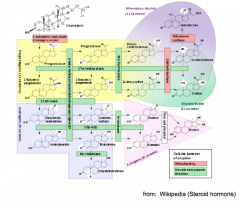
Draw out this bitch again... |
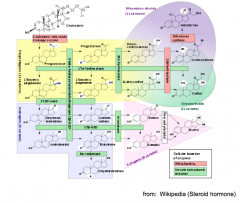
|
|
|
What are the two major functions of the testes? What is the blood supply? What is the temperature needed?
What muscle moves the testes?
|
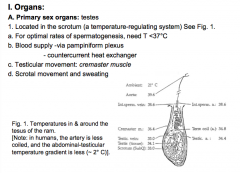
1. Makes gametes 2. Makes testosterone
Needs to be about 2-3 degrees lower than the body temperature |
|
|
What are the components of the genital tract?
Which accessory glands have 60% of seminal volume and contain prostaglandins, fructose, citric acid, etc.
Which gland has 20% of seminal volume?
What are secondary sex characteristics?
What pubertal changes can be reversible by decreasing gonadotropic and/or androgen secretion?
Which changes are NOT reversible?
What do the prostaglandins do? |

Prostglandins = cause contraction of vagina? |
|
|
What do the testes make? |
Testosterone and gametes |
|
|
What two hormones are required for spermatogenesis?
Which ones are indirectly required?
What are the functions of the Sertoli cells? -site of action of what hormones -does what for developing sperm -proves what barrier to chemical -produces what hormones that negatively feedback FSH -secrete what fluid (including what binding protein) -phagocytosis of what?
|
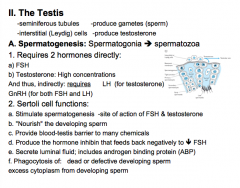
|
|
|
What is testosterone production, transport, metabolism, action stimulated by?
What type of secretion of this hormone? Thus, testosterone is what type of secretion?
BUT: Relative to the changes in gonadotrophins, estrogen and progesterone in females over a month, the plasma levels of LH, FSH, and testosterone in males are relatively __________. |

|
|
|
Metabolism: a. Activation. In some target tissues, testosterone (T) must be metabolized to __________in order to reach nucleus and produce androgenic actions.
Draw pathway.
What are some examples that require formation to DHT? |
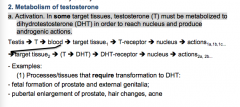
|
|
|
(2) Processes/tissues that do not require transformation, i.e. testosterone is the _______ hormone in nucleus: -pubertal growth of ______ , ______, _____; -libido b. Testosterone degraded by _______, like other steroids. Metabolites excreted in ______. (Sulfated and ________; excreted as 17- ketosteroids). c. Conversion to ________ (aromatization) -in adipose tissue, ________, hypothalamus.
3. Transport of testosterone: a. In blood: ______ ________-Binding Globulin (GBG) Testosterone Binding Globulin (TeBG) Testosterone/_________ Binding Globulin (TEBG) and albumin: ( ~ 30% ) Free T: ~_______% b. To cells of the epididymis: not from _______, Testosterone reaches these cells mostly via _________ (carried from testis bound to ABP) |
(2) Processes/tissues that do not require transformation, i.e. testosterone is the active hormone in nucleus: -pubertal growth of skeletal muscle, penis, scrotum; -libido b. Testosterone degraded by liver, like other steroids. Metabolites excreted in urine. (Sulfated and glucuronated; excreted as 17- ketosteroids). c. Conversion to estradiol (aromatization) -in adipose tissue, pituitary, hypothalamus. 3. Transport of testosterone: a. In blood: Gonadal steroid-Binding Globulin (GBG) Testosterone Binding Globulin (TeBG) Testosterone/Estrogen Binding Globulin (TEBG) and albumin: ( ~ 30% ) Free T: ~_3% b. To cells of the epididymis: not from blood, Testosterone reaches these cells mostly via luminal fluid (carried from testis bound to ABP) |
|
|
4. Actions of testosterone (and other androgens)
a. ________ fetal differentiation of male accessory organs e.g., seminal vesicles, prostate, increase fructose content, volume of secretions d. _______ spermatogenesis g. Feedback inhibition of ________ secretion -Yes in some animals No solid evidence ___ in men ________ |
4. Actions of testosterone (and other androgens) a. Induce fetal differentiation of male accessory organs e.g., seminal vesicles, prostate, increase fructose content, volume of secretions d. Stimulate spermatogenesis g. Feedback inhibition of LH secretion -Yes in some animals No solid evidence ___ in men NO |
|
|
C. Regulation of pituitary-testicular axis: See Fig 2. between pulses) weaker ____ of FSH It takes______ amounts of androgens to shut off FSH enough to _____ size of seminiferous tubules. Bodybuilders know they are overdosing when their testes start to ______ (since seminiferous tubules occupy most of the volume of the testes). 3. Inhibin: at pituitary (not hypothalamus): ____ FSH 4. Estrogens: ____ pulse frequency of GnRH |

|
|
|
Draw the pathway of the control of testicular function from hypothalamus to testis. |
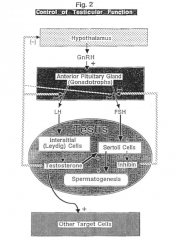
|
|
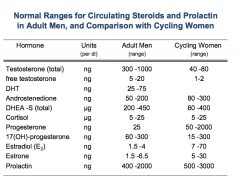
Just look over. |
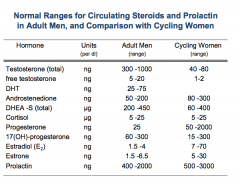
|
|
|
What are the sources of testosterone in men? |
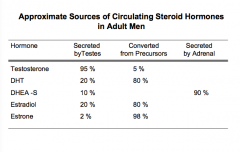
|
|
|
What happens as males age? (which hormones increase and which decrease)
DHEA-S Testosterone androgens Gonadotrophins |
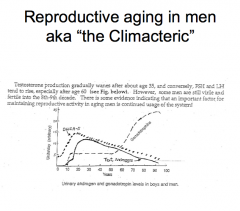
|
|
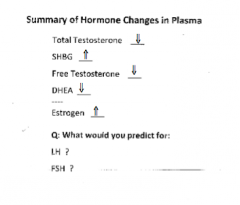
|
Both increased because both have lost inhibition |
|
|
What is the primary female sex organ?
What are some of the secondary sex organs in females? |

|
|
|
How many eggs are left by puberty? |
400,000 |
|
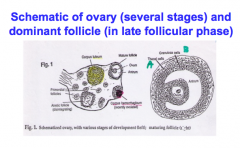
Look over |

|
|
|
What stimulates growth and hormonal secretion of both the ovaries and the follicles that produced the estrogen, particularly in the dominant follicle? |
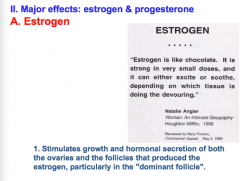
|
|
|
What happens to estradiol levels at LH, FSH peak? What predominates after peak? |
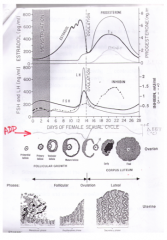
|
|
|
2. Negative and positive feedback effects on hypothalamus and anterior pituitary (i.e., on GnRH, FSH, and LH secretion). low [E] ___ on LH and FSH rising [E] ____ LH and FSH leads to mid-cycle LH surge that causes ovulation very high [E] ___ (was used as birth control not any more due to side effects from E) v. low [E] + progesterone (moderate dose) ___ and used in birth control pills. |
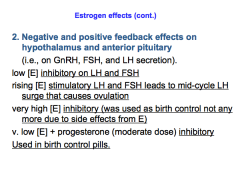
|
|
|
What does progesterone inhibit? What does estradiol stimulate and inhibit?
|
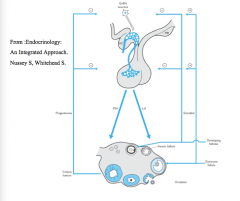
|
|
|
What does estrogen produce in terms of figuration? |

|
|
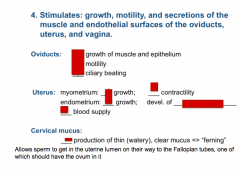
|

|
|
|
What are the estrogen effects on uterine endrometrium? |
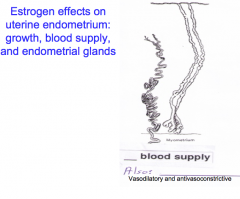
Generation of glands, vasodilatory and antivasoconstrictive |
|
|
What pattern will you see in cervical mucus when under influence of high levels of estradiol? |
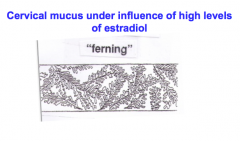
|
|
|
What does estrogen do to the vagina (fluid and growth)? What is this process called? |
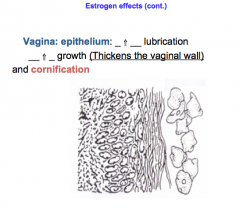
|
|
|
5. Stimulates growth of the ______ glands: esp. _____ of the ducts; and _______ deposition; also increase deposition of _______ (stroma) nipples and areolae: growth & _______ |
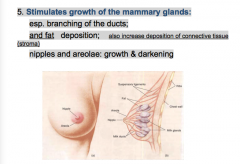
|
|
|
Estrogen effects (cont.) 6. Induces _______ receptors in the uterine endometrium. Why is this important?
This allows the endometrium to respond to the increased progesterone in the ______ phase, and thus make a ________ endothelium (the endothelial glands that have formed due to estrogen in the proliferative phase now become _____, which includes providing ___ to nourish the cells of the blastocyst that is floating in the lumen before it implants, and also during implantation); also and endometrium that can be "invaded" by the blastocyst (i.e. be receptive to the blastocyst, allowing it to burrow in and begin establishing the placental _____) |
Estrogen effects (cont.) 6. Induces progesterone receptors in the uterine endometrium. Why is this important? This allows the endometrium to respond to the increased progesterone in the luteal phase, and thus make a secretory endothelium (the endothelial glands that have formed due to estrogen in the proliferative phase now become secretory, which includes providing glycogen to nourish the cells of the blastocyst that is floating in the lumen before it implants, and also during implantation); also and endometrium that can be "invaded" by the blastocyst (i.e. be receptive to the blastocyst, allowing it to burrow in and begin establishing the placental circulation) |
|
|
Estrogen effects (cont.)
7. Long bone growth: Causes the epiphyseal cartilage plates of long bones to ____; thus, halts height growth. -BUT, initially, _____ stimulate height growth (possibly by stimulating ____ secretion).
8. Promotes growth of female external ______.
9. Beneficial effects on _______ metabolism & lipoproteins (elevates ___and lowers ___); anti- atherogenic. |
Estrogen effects (cont.)
7. Long bone growth: Causes the epiphyseal cartilage plates of long bones to "close"; thus, halts height growth. -BUT, initially, estrogens stimulate height growth (possibly by stimulating GH secretion).
8. Promotes growth of female external genitalia.
9. Beneficial effects on cholesterol metabolism & lipoproteins (elevates HDL and lowers LDL); anti- atherogenic. |
|
|
What are the effects of estrogen on plasma lipids? |
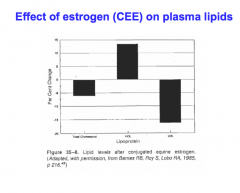
anti-artherogenic |
|
|
Estrogen effects (cont.)
10. Other effects of estrogens b. ___ Prl secretion; c. Bones: anti-_______ (_____ cytokine signals from osteoblasts to osteoclasts; thus,___ bone loss). |
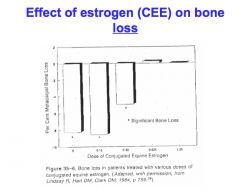
Estrogen effects (cont.)
10. Other effects of estrogens b. _⇑__ Prl secretion; c. Bones: anti-osteoporotic (⇓ cytokine signals from osteoblasts to osteoclasts; thus, ⇓ bone loss). |
|
|
Estrogen effects (cont.)
d. ___ libido (together with androgens) e. Appetite:_____ EFFECTS, depends on species: In some animals (like RATS) E=> ___ appetite & eating (& thus, ___ growth [wt gain]) But E=>increased ____ in others,.like cattle Humans: (____ on appetite) in humans - effects are not clear, although SOME women report changes in food preferences at various stages of their cycles, including pre-ovulation, when E2 is high. |
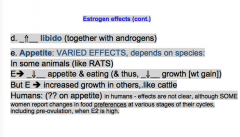
|
|
|
Progesterone B. Actions of Progesterone PROmotes _______ 1. Uterine muscle: _______ a) ______ motility and prevents contractions from being coordinated. b) ______ estrogen's enhancement of motility - partly by ____ the number of estrogen receptor (on smooth muscles of the female tract c) ______ sensitivity to oxytocin |
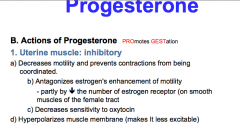
|
|
|
Endometrium (PROGESTERONE): Stimulatory or Inhibitory After priming of tissue with estrogen, progesterone _______ secretion by endometrial glands lining the _______. - This prepares _______ for Implantation. Pituitary: ______ LH & FSH secretion, especially when ______ estrogen present. _______mammary gland growth, especially the milk producing glands; Inhibits ______ (or hPL) stim. of milk synthesis. _____ body temperature (thus, the rise In BBT beginning a few days post-ovulation). Other a)______ chances of other sperm to get into the uterus and b) (most important) provide a barrier to potentially damaging microorganisms from getting into the uterus and into the developing fetus. |
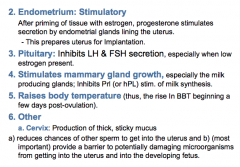
|
|
|
PROGESTERONE
7.________ and _____ feedback effects on hypothalamus and anterior pituitary (i.e., on GnRH, FSH, and LH secretion). very _______ progesterone alone is _____ Used in birth control. |
7. Negative and positive feedback effects on hypothalamus and anterior pituitary (i.e., on GnRH, FSH, and LH secretion). very high progesterone alone is inhibitory Used in birth control. |

